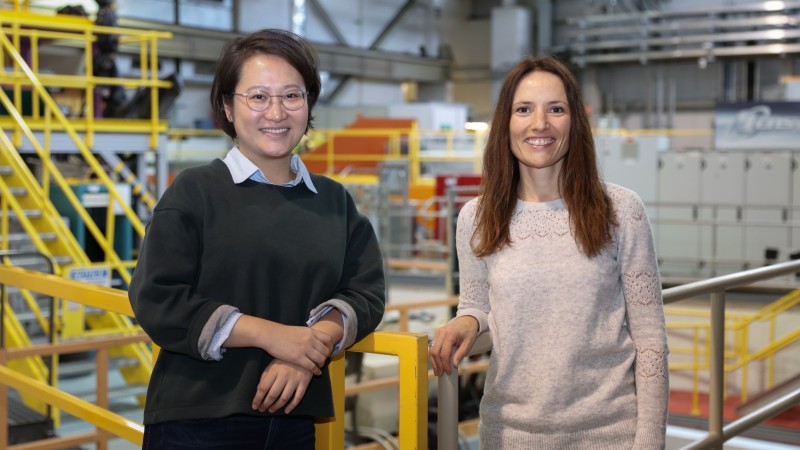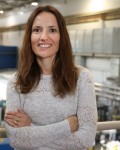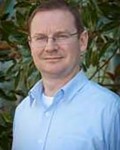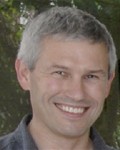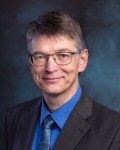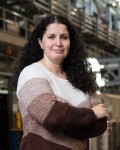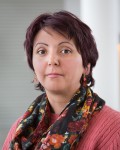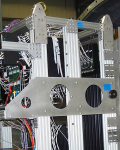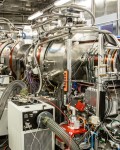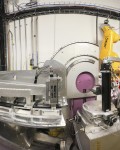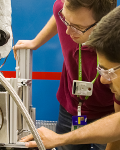Yue Yuan, a second-year PhD student at NC State University’s Wilson College of Textiles, is working to create textiles that filter carbon dioxide (CO2) by using the latest scientific techniques in synthesis and imaging. Known as biocatalytic textiles, these materials could serve as sustainable scrubbers for CO2 capture by using enzymes trapped in bio-based polymers to catalyze the hydration of CO2.
“These are new materials that combine the catalytic properties of enzymes with the flexibility of textiles,” Yuan said.
When she began her doctorate studies, Yuan, who has a research background in textile science, wanted to learn more about the different properties of enzymes and polymers that could be used to improve the performance of biocatalytic textiles. So she began taking biochemistry classes.
That’s how Yuan first heard about neutron scattering from Flora Meilleur, a joint faculty member at NC State. Meilleur is also a structural biologist at the US Department of Energy’s (DOE’s) Oak Ridge National Laboratory (ORNL) who specializes in protein chemistry and neutron crystallography at ORNL’s two neutron sources—the Spallation Neutron Source (SNS) and the High Flux Isotope Reactor (HFIR).
SNS and HFIR are DOE Office of Science User Facilities that annually attract more than 1,200 researchers to Oak Ridge to image and analyze materials and their properties using neutrons—electrically neutral particles that scatter off a material’s atoms, generating structural data that often cannot be obtained with other techniques such as x-rays. The noninvasive nature of neutrons makes them an ideal tool for studying biological materials, such as the polymers Yuan is interested in for her research.
At NC State, Yuan uses electron and x-ray techniques to study the structures and interactions of polymers and enzymatic proteins for her textiles, but these methods were not producing all the data she needed.
“The challenge of using electrons is that the materials I’m researching are bio-based, and they don’t have enough electrons to interact with the probe,” Yuan said. “But neutrons can fill this hole in characterization.”
A member of Yuan’s PhD committee, Meilleur pointed out the potential of neutrons to her. Meilleur shared articles about neutron scattering, but Yuan still had questions about how the instruments worked and how she would interpret and use the data.
“How do you turn neutron scattering data into the information you want?” she asked.
Meilleur suggested Yuan visit ORNL’s Center for Structural Molecular Biology (CSMB) and neutron user facilities to get an immersive introduction to neutron science. CSMB operates a neutron scattering instrument called Bio-SANs that is dedicated to biological samples at HFIR, and a bio-deuteration laboratory for preparing biological samples for neutron analysis.
“Meeting with expert scientists and visiting facilities is the best possible way for a graduate student to learn about new techniques and find out how they can be applied in their research area,” Meilleur said. “Yue’s opportunity to spend a week at ORNL was an invaluable, concrete learning experience.”
Yuan applied for a professional development grant opportunity from Wilson College of Textiles through the Ellen Rohde Leadership Initiative, which aims to support women in the college with leadership training. Through the initiative, Yue was awarded funding for a one-week trip to Oak Ridge.
“At first, I was hesitant because I had limited knowledge of neutrons, but after visiting, it’s clear what is possible,” Yuan said. “I’ve talked to experts on enzymes, biomolecules, and polymers and received positive feedback about my work.”
During her visit, Yuan toured both neutron user facilities and met with ORNL scientists, including Hugh O’Neill, CSMB director; Dean Myles, an instrument scientist for the IMAGINE diffractometer for biochemistry at HFIR; Urban Volker, an instrument scientist for Bio-SANS; Hassina Bilheux, an instrument scientist for the Neutron Imaging Facility at HFIR; Laura Stingaciu, an instrument scientist for the Neutron Spin Echo Spectrometer at SNS; John Ankner, an instrument scientist for the Liquids Reflectometer at SNS; Kevin Weiss, a CSMB protein chemist; Kunlun Hong, a Center for Nanomaterials Sciences material scientist; and Tomonori Saito, a synthetic polymer chemist and expert in CO2 separation.
“I toured different beamlines and talked with experts on the potential of different instruments for my research. What I found in Oak Ridge were world-class instruments,” Yuan said.
During her meetings with ORNL neutron scientists, Yuan discussed techniques like reflectometry for studying surfaces and interfaces and spectroscopy for measuring atomic motion and magnetism.
“I found scientists willing to help,” she said. “I learned how to start experiments and what kind of challenges I may be met with.”
Yuan and Meilleur met daily to discuss what information Yuan found useful for her research on biocatalytic textiles.
“I would come back to Dr. Meilleur at the end of each day with feedback, so we kept updating my schedule for the next day,” Yuan said.
Among Yuan’s objectives for her week at ORNL, she sought advice on writing a proposal for beam time at SNS and HFIR so that she might apply her first-hand knowledge of neutrons to collecting data and advancing her research.
“Now I know there are neutron instruments that can be linked to my research and that will work together with electron microscopy so I can study the polymer dynamics,” Yuan said.
HFIR and SNS are DOE Office of Science User Facilities. UT-Battelle manages ORNL for DOE’s Office of Science. The Office of Science is the single largest supporter of basic research in the physical sciences in the United States and is working to address some of the most pressing challenges of our time. For more information, please visit http://science.energy.gov/. - Katie Jones


